
Gian LorenzoBernini was an Italian sculptor and architect. While a major figure in the world of architecture, he was more prominently the leading sculptor of his age, credited with creating the Baroque style of sculpture. As one scholar has commented, "What Shakespeare is to drama, Bernini may be to sculpture: the first pan-European sculptor whose name is instantaneously identifiable with a particular manner and vision, and whose influence was inordinately powerful ..." In addition, he was a painter and a man of the theatre: he wrote, directed and acted in plays, for which he designed stage sets and theatrical machinery. He produced designs as well for a wide variety of decorative art objects including lamps, tables, mirrors, and even coaches.
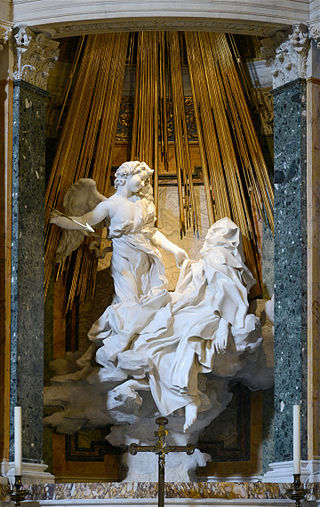
The Ecstasy of Saint Teresa is a sculptural altarpiece group in white marble set in an elevated aedicule in the Cornaro Chapel of the church of Santa Maria della Vittoria in Rome. It was designed and carved by Gian Lorenzo Bernini, the leading sculptor of his day, who also designed the setting of the chapel in marble, stucco and paint. The commission was completed in 1652.

Charity with Four Children is a sculpture by the Italian artist Gian Lorenzo Bernini. Executed between 1627 and 1628, the work is housed in the Vatican Museums in Vatican City. The small terracotta sculpture represents Charity breast-feeding a child, with three other children playing. There is an imprint of Bernini's thumbprint in the clay.

François Duquesnoy or Frans Duquesnoy was a Flemish Baroque sculptor who was active in Rome for most of his career, where he was known as Il Fiammingo. His idealized representations represented a quieter and more restrained version of Italian baroque sculpture, and are often contrasted with the more dramatic and emotional character of Bernini's works, while his style shows a great affinity to Algardi's sculptures.

Francesco Mochi was an Italian early-Baroque sculptor active mostly in Rome, Piacenza and Orvieto. His dramatic early works in Orvieto are now often regarded as the first truly Baroque sculptures.

Fontana del Moro is a fountain located at the southern end of the Piazza Navona in Rome, Italy. It depicts a nautical scene with tritons, dolphins, and a conch shell. It was originally designed by Giacomo della Porta in the 1570s with later contributions from Gian Lorenzo Bernini in the 1650s. Bernini sculpted a large terracotta model of the central figure, which Giovanni Antonio Mari used as a guide when sculpting the final figure. There is a debate around whether or not the central figure was intended by Bernini to depict a Moor. Some of the original sculptures were moved to the Galleria Borghese in 1874. In 2011, the fountain was vandalized.

Apollo and Daphne is a life-sized marble sculpture by the Italian artist Gian Lorenzo Bernini, which was executed between 1622 and 1625. It is regarded as one of the artistic marvels of the Baroque age. The statue is housed in the Galleria Borghese in Rome, along with several other examples of the artist's most important early works. The sculpture depicts the climax of the story of Apollo and Daphne, as written in Ovid's Metamorphoses, wherein the nymph Daphne escapes Apollo's advances by transforming into a laurel tree.

Filippo Parodi was an Italian sculptor of the Baroque period, "Genoa's first and greatest native Baroque sculptor".

Blessed Ludovica Albertoni is a funerary monument by the Italian Baroque artist Gian Lorenzo Bernini. The Trastevere sculpture is located in the specially designed Altieri Chapel in the Church of San Francesco a Ripa in Rome, Italy. Bernini started the project in 1671, but his work on two other major works—The Tomb of Pope Alexander VII and the Altar of the Blessed Sacrament in St. Peter's Basilica—delayed his work on the funerary monument. Bernini completed the sculpture in 1674; it was installed by 31 August 1674.
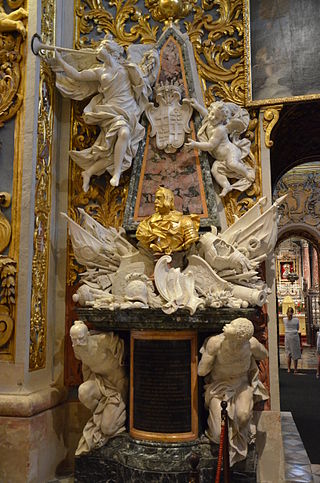
Domenico Guidi was a prominent Italian Baroque sculptor.

The Rape of Proserpina, more accurately translated as the Abduction of Proserpina, is a large Baroque marble group sculpture by Italian artist Gian Lorenzo Bernini, executed between 1621 and 1622, when Bernini's career was in its early stage. The group, finished when Bernini was just 23 years old, depicts the abduction of Proserpina, who is seized and taken to the underworld by the god Pluto. It features Pluto holding Proserpina aloft, and a Cerberus to symbolize the border into the underworld that Pluto carries Proserpina into.

Andrea Bolgi was an Italian sculptor responsible for several statues in St. Peter's Basilica, Rome. Towards the end of his life he moved to Naples, where he sculpted portrait busts. He died in Naples during a plague epidemic.
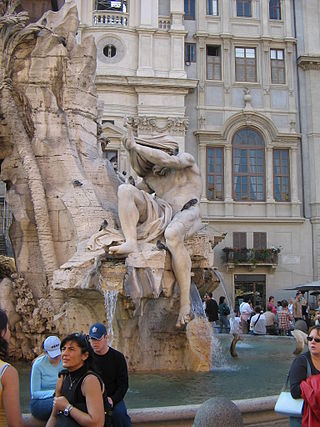
Giacomo Antonio Fancelli or Iacopo Antonio Fancelli (1606–1674) was an Italian sculptor in stone and stucco of the Baroque era.

The Martyrdom of Saint Lawrence is an early sculpture by the Italian artist Gian Lorenzo Bernini. It shows the saint at the moment of his martyrdom, being burnt alive on a gridiron. According to Bernini's biographer, Filippo Baldinucci, the sculpture was completed when Bernini was 15 years old, implying that it was finished in the year 1614. Other historians have dated the sculpture between 1615 and 1618. A date of 1617 seems most likely. It is less than life-size in dimensions, measuring 108 by 66 cm.
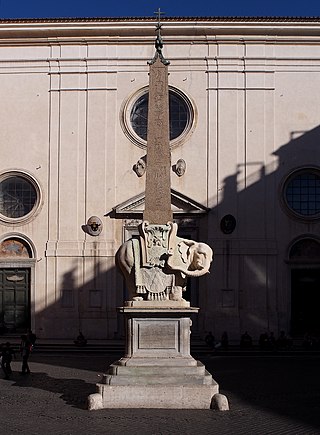
Elephant and Obelisk is a statue of an elephant carrying an obelisk, designed by the Italian artist Gian Lorenzo Bernini. It was unveiled in 1667 in the Piazza della Minerva in Rome, adjacent to the church of Santa Maria sopra Minerva, where it stands today.
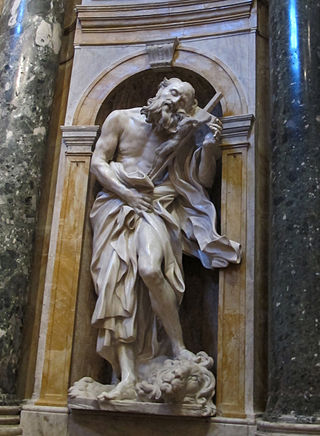
Saints Jerome and Mary Magdalen are two sculptures by the Italian artist Gianlorenzo Bernini. They sit in the Chigi Chapel of Siena Cathedral. The statues were commissioned as part of the chapel by the then–pope Alexander VII.

The Vision of Constantine is an equestrian sculpture by the Italian artist Gian Lorenzo Bernini, located in the Scala Regia by St. Peter's Basilica in Vatican City. Originally commissioned as a free standing work of art within St. Peter's itself, the sculpture was finally unveiled in 1670 as an integral part of the Scala Regia - Bernini's redesigned stairway between St. Peter's Basilica and the Vatican Palace. Unlike other large works by Bernini, art historians have suggested that this work was almost entirely undertaken by him - no other sculptors have been recorded as receiving payment. Bernini's overall fee was 7,000 Roman scudi.

Daniel and the Lion is a sculpture created by Gian Lorenzo Bernini c. 1655–57. Standing in a niche in the Chigi Chapel in the Basilica of Santa Maria del Popolo in Rome, it shows the Prophet Daniel in the lions' den. It forms a part of a larger composition with the sculpture of Habakkuk and the Angel diagonally opposite.

Habakkuk and the Angel is a sculpture created by Gian Lorenzo Bernini c. 1656–61. Standing in a niche in the Chigi Chapel in the Basilica of Santa Maria del Popolo in Rome, it shows the Prophet Habakkuk with the angel of God. It forms a part of a larger composition with the sculpture of Daniel and the Lion diagonally opposite.
Dickerson III, C.D., Anthony Sigel, and Ian Wardropper. Bernini: Sculpting in Clay. New Haven: Yale University Press, 2012.
H. Frezza after C. Patacchia after Gianlorezno Bernini, Saint Longinus, 1696. Engraving. Wellcome Collection, London.
Harris, Ann Sutherland. "New Drawings by Bernini for 'St. Longinus' and Other Contemporary Works." Master Drawings 6, no. 4 (Winter 1968): 383-391+432-447.
Neuman, Robert. Baroque and Rococo Art and Architecture. New York City: Pearson, 2013.
Poseq, Avigdor W.G. "On Physiognomic Communication in Bernini." Artibus et Historiae 27, no. 54 (2006): 161–190.
Wittkower, Rudolf. Bernini, the Sculptor of the Roman Baroque. London: Phaidon Press, 1997.




















